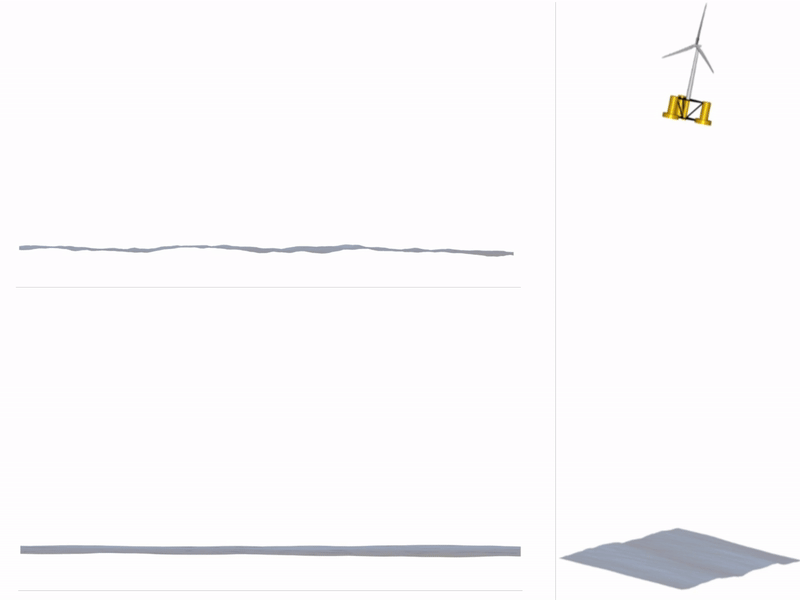Forum
Wave forces
Quote from Hannes W on 15. May 2023, 09:04Hi,
I’m modelling a foundation and I want to know the forces that act on the foundation due to the wind and wave loads. I used the model file ‘NREL 5MW Monopile’ to start with. I get forces in the x-direction of about 0.5 MN which seems ok to me. When I run a simulation with only wave action and no wind I get a force in the x – direction up to 0.1 MN. This seems to small compared to a hand calculation (Fx ~1MN).
Now I have used ‘QBLIB.getTowerBottomLoads_at_num(loads,0)’ to obtain the loads at the bottom of the tower. Is this the sum of the wind and wave load? Is there a function that gives only the load due to the wave action as well?
Kind regards,
Hannes
Hi,
I’m modelling a foundation and I want to know the forces that act on the foundation due to the wind and wave loads. I used the model file ‘NREL 5MW Monopile’ to start with. I get forces in the x-direction of about 0.5 MN which seems ok to me. When I run a simulation with only wave action and no wind I get a force in the x – direction up to 0.1 MN. This seems to small compared to a hand calculation (Fx ~1MN).
Now I have used ‘QBLIB.getTowerBottomLoads_at_num(loads,0)’ to obtain the loads at the bottom of the tower. Is this the sum of the wind and wave load? Is there a function that gives only the load due to the wave action as well?
Kind regards,
Hannes
Quote from David on 15. May 2023, 11:07Hi Hannes,
the “TowerBottomLoads” are the combined forces/moments acting on the bottom of the tower, which in case of the monopile model are the forces that are acting on the interface between tower and monopile.
Since the monopile is modeled as a flexible substructure the forces acting on it are distributed. You can eccess the various hydrodynamic forces acting on the monopile in the “Hydrodynamic Time Graph” and the interbal forces in the monopile in the “Structural Time Graph”.
This part of the documentation explains how to distribute virtual sensors along the substructure.
BR,
David
Hi Hannes,
the “TowerBottomLoads” are the combined forces/moments acting on the bottom of the tower, which in case of the monopile model are the forces that are acting on the interface between tower and monopile.
Since the monopile is modeled as a flexible substructure the forces acting on it are distributed. You can eccess the various hydrodynamic forces acting on the monopile in the “Hydrodynamic Time Graph” and the interbal forces in the monopile in the “Structural Time Graph”.
This part of the documentation explains how to distribute virtual sensors along the substructure.
BR,
David
Quote from Hannes W on 17. May 2023, 10:35Hi David,
Thanks for your response. I added
SUB_1_0.5
SUB_5_0.5
SUB_10_0.5
SUB_15_0.5
SUB_20_0.5
SUB_25_0.5
SUB_30_0.5
SUB_35_0.5to the bottom of the file that defines the substructure. Now I can see the wave load at these points ( X_l For. SUB_ID 5 pos 0.500 [N]). The strange thing is however that these loads are larger near the bottom than at the top of the substructure. This is not what you would expect I think? I think the numbering of the nodes starts at the seabed as the attached screenshot of the substructure suggests?
kind regards,
Hannes
Hi David,
Thanks for your response. I added
SUB_1_0.5
SUB_5_0.5
SUB_10_0.5
SUB_15_0.5
SUB_20_0.5
SUB_25_0.5
SUB_30_0.5
SUB_35_0.5
to the bottom of the file that defines the substructure. Now I can see the wave load at these points ( X_l For. SUB_ID 5 pos 0.500 [N]). The strange thing is however that these loads are larger near the bottom than at the top of the substructure. This is not what you would expect I think? I think the numbering of the nodes starts at the seabed as the attached screenshot of the substructure suggests?
kind regards,
Hannes
Uploaded files:- You need to login to have access to uploads.
Quote from David on 8. July 2023, 13:16Hi Hannes,
I guess you are looking at the forces within the structural time graph? These are the total internal forces acting on the substructure elements, which are a combination of wave forces, inertia, drag, gravity, etc.. Depending on the actual movement of the substructure it could very well be that the forces experienced at the bottom are larger than those seen at the top.
If you check out the hydrodynamic time graph you can see the individual contributions of different hydrodynamic forces towards this total internal force. And there the wave forces at the top should be larger as you mention.
BR,
David
Hi Hannes,
I guess you are looking at the forces within the structural time graph? These are the total internal forces acting on the substructure elements, which are a combination of wave forces, inertia, drag, gravity, etc.. Depending on the actual movement of the substructure it could very well be that the forces experienced at the bottom are larger than those seen at the top.
If you check out the hydrodynamic time graph you can see the individual contributions of different hydrodynamic forces towards this total internal force. And there the wave forces at the top should be larger as you mention.
BR,
David


